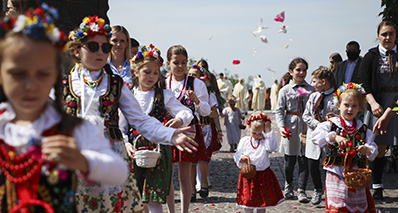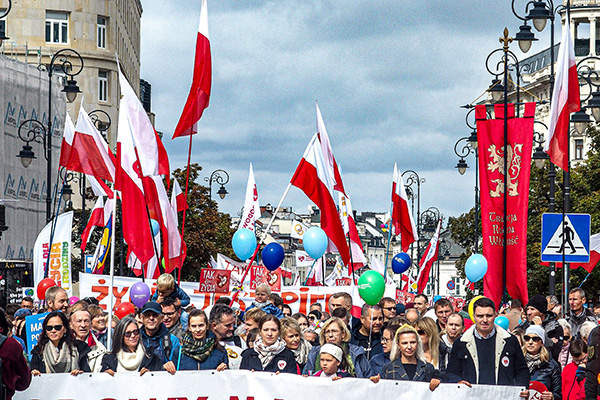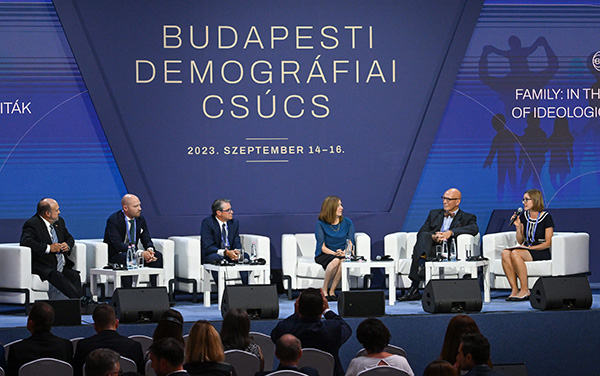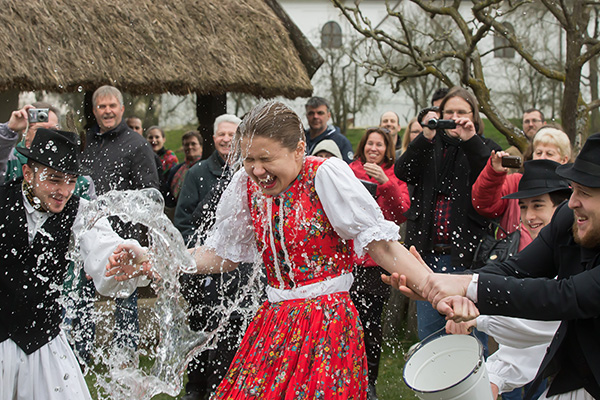Credit Image: © Beata Zawrzel/NurPhoto via ZUMA Press
Subscribe to future audio versions of AmRen articles here.
[Editor’s note: This article was written before yesterday’s legislative elections in Poland. According to preliminary results, the ruling Law and Justice Party got the most votes but failed to win a majority of seats. The pro-Brussels leader of the opposition Civic Coalition, Donald Tusk, appears to have a better chance at forming a coalition government. He has promised to maintain Law and Justice’s immigration control and incentives for higher birth rates, but would follow the EU’s lead on migrant policy.]
“The demographic winter which has afflicted the developed world is now turning into an Ice Age. . . . If fewer children continue to be born each year than the number of those who pass away, our beloved world that we assumed to be secure will wither away. . . .”
Such were the words of Hungary’s president Katalina Novák this year at the fifth Budapest Demography Summit.
Before being elected president of Hungary last year by parliament, Miss Novák had been family minister for several years in the government of Prime Minister Viktor Orbán. Since Mr. Orbán’s Fidesz party returned to power in 2010, boosting natality and supporting families have been among its flagship programs. This small Central European country of fewer than 10 million people is now spending the equivalent of 5 percent of its GDP — more than any other EU member state — to support families, and for years, it has regularly been cited as an example to follow.
Yet the country saw the number of babies born last year decline again, down from 93,039 the year before to 88,491. Since 2010, the annual number of births in Hungary has hovered around 90,000 babies. This, combined with an aging population and a rising number of deaths, has led to the steepest population loss by this 1,000-year-old nation since the end of World War II.
The same can be said of Poland, which embraced Hungary’s emphasis on natality and the family when the conservative Law and Justice party took power in 2015.
While Viktor Orbán’s Fidesz won its fourth consecutive absolute majority last year and is sure to govern Hungary for at least the next three years (despite efforts by the American Left), Poles voted on October 15 whether Law and Justice should keep governing after two consecutive victories, in 2015 and 2019, during which it enjoyed an absolute majority in the Polish parliament.
As for Law and Justice’s pro-natalist policies, 2021 and 2022 were the years with the smallest number of babies born in Poland since the end of World War II. This downward trend has continued since 2012.
The Polish population, like that of Hungary, is shrinking, and in 2016, Law and Justice introduced its pro-natalist program. It offered a benefit of 500 Polish zlotys ($115) per month for each child in a family regardless of income, beginning with the second child. (Parents who meet certain qualifications get the payment even for their first child.) The program was quickly hailed a success after the number of births in 2017 passed the 400,000 mark for the first time in many years.
However, the number of newborn babies in 2022 in Poland was down 27,000 to just 305,000 last year, and the population declined to 37.8 million, 141,000 fewer than the year before. Poland’s total fertility rate, therefore, has fallen back to its 2013 level of 1.26. It reached 1.45 in 2017 but has since dropped steadily.
September 18, 2022, Warsaw, Poland: A National March for Life and Family organized by The Center of Life and Family, a Polish conservative movement focused on preserving family. The movement is aimed at anti-abortion, family values and anti-divorce. (Credit Image: © Bianca Otero/ZUMA Press Wire)
Low birthrates combined with economic growth and emigration of young people, which happened after Central European countries joined the European Union in 2004, have led to serious labor shortages in Poland and Hungary. In spite of the anti-immigration rhetoric of both governments, this led to record levels of legal non-European immigration.
This conflict between needing workers and wanting to retain national identity became a major issue in the run-up to Poland’s October 15 elections. The opponents of Law and Justice accused the party of hypocrisy for its staunch opposition to the new Migration Pact of the European Union while continuing to issue work visas to foreigners (see below).
The Migration Pact is supposed to help frontline countries such as Italy and Greece under the guise of “compulsory solidarity.” It would require any EU member state that refuses to take in its “share” of migrants to pay at least €20,000 per migrant refused.
The frontline countries are certainly under threat. Italians, for example, despite having elected Giorgia Meloni — who had promised to introduce a naval blockade against illegal immigrants — are faced with a true invasion through the island of Lampedusa, halfway between Tunisia and Sicily. Italy is also witnessing many arrivals from the Balkans (via the Balkan route leading from Turkey) at its land border with Slovenia, of which we hear much less in the media.
At the same time as the parliamentary elections on October 15, Poland held a referendum on whether to accept the EU migration pact and whether the anti-migrant barrier at the border with Belarus should be dismantled.
There was overwhelming support — more than 95 percent — to reject immigrants and maintain the barrier. However, opposition parties had called a boycott of the referenda, which was successful. Despite overall voter turnout of 73 percent, only about 40 percent took part in the referenda, meaning that the results are non-binding.
Despite general opposition to immigration, the Polish government has awarded hundreds of thousands of work visas to non-Europeans, including a number from Muslim countries. In 2022, most residence permits granted by Poland were given to Belarusians and Ukrainians, people who are close to the Poles ethnically, culturally, and linguistically (all three peoples are Slavic). Turks came in third, followed by Indians, Georgians, Moldavians, Uzbeks, Filipinos, and Azeris. That year, Poland granted some 33,000 visas to citizens of Muslim countries.
Compared to Western European countries such as Germany, France, or the UK, non-Europeans do not come in large numbers. Nevertheless, Poland issues more work visas than any other EU country. In the last three years, it added almost two million workers from outside the EU to its population of 38 million.
Many of those newcomers are thought to have used Poland as an entry to the EU and have since moved west, where paychecks are higher. This explains why, at the end of 2022, the Polish compulsory social insurance ZUS had “only” a little over one million registered non-EU workers, including 746,000 Ukrainians.
Poland has the conflicting priorities of Central European countries that want economic growth despite population decline and a rapidly aging population.
Labor immigration that started with reasonable numbers was how today’s uncontrolled immigration started in Western Europe, and in Poland, the number of Muslims began from a low base. Ten years ago, there were an estimated 15,000 to 30,000, including a few thousand Polish Tatars, whose presence dates to the 14th century.
If births continue to be low and there is no mass immigration, Central Europe could see its population shrink by about a third by the end of the century. For the Visegrád Group (V4) — Poland, Czechia, Slovakia, and Hungary — there could be a drop from today’s 63 million citizens to 44 million in 2100.
Those four countries and some of their Central European neighbors have come to realize how important birth rates are for their survival. Although the fall in the number of births cannot be reversed quickly because of the decline in the number of women of reproductive age, there are still reasons for hope.
First, some countries are being careful not to make labor immigration permanent. Last summer, Hungary welcomed an additional 200,000–300,000 migrant workers on top of the usual 100,000, but only under strict conditions. Those additional workers acquire no right to settle in Hungary and will have to leave the country after their visas expire. This change was motivated by the realization that new labor migrants will have to come from farther away than the current ones, of whom about half are from neighboring countries.
That, by the way, is the same rule enforced by rich Arab countries that import many of their workforce from countries such as India and the Philippines. Strangely enough, most European countries seem to have never thought of applying this very sensible rule, which makes it beneficial for all. Migrants from poorer countries earn good money for a few years to support their families, and go home with new skills. Their countries of origin do not lose their most able people to wealthier countries, and the wealthier countries do not lose control of immigration.
And there is hope on the natality front.
If we take again the example of Hungary, which was the first post-Communist country in Central Europe to stand up to the problem back in 2010, the total fertility rate (TFR) has been rising. It is now 1.6 children per woman instead of the 1.2 in 2010.
The biennial Budapest International Demographic Summit in the Museum of Fine Arts in Budapest, Hungary, September 15, 2023. (Credit Image: © Tibor Illyes/EFE via ZUMA Press)
That is still well below the 2.1-children-per-woman necessary for generation replacement, but the decline has been reversed. The reason why this does not translate into a rise in the number of live births is simple: As in other countries, pro-family policies came late, at a time when there were fewer women of reproductive age. More children per woman therefore does not have to mean more children in absolute terms.
For this reason, reversing Central Europe’s demographic ice age will take many years. Western Europe isn’t even trying, having chosen to import more people instead. A potential exception is Giorgia Meloni’s Italy, which now has one of Europe’s lowest TFRs, but is starting to take the problem seriously. For a description of pro-family policies in Poland and Hungary in comparison with those of Germany and France (as of 2019), see “How to deal with population decline – an overview” on the website of the Felczak Institute for Polish-Hungarian Cooperation.
Barbara Socha, the Polish secretary of state for demographic policy, gave an interview to Remix News in May, in which she identified the problems. According to a CBOS survey published earlier this year (in Polish), 42 percent of childless women aged 18–45 told pollsters they do not plan to have children or do not know whether they will have children. In the same survey conducted in 2017, only 22 percent gave that answer. This is despite increased support for families with children.
Poland has just introduced two new measures to boost births: mortgages at a guaranteed rate of 2 percent for people up to age 45 to buy a first home and, starting next January 1, an increase of the monthly child allowance from 500 zlotys per child to 800 zlotys. (Right now, the Poles’ average monthly pay is a little over 7,000 zlotys a month, before income tax but after social contributions.)
However, as shown by the Polish survey, there must be a change in mentality. In that area, Hungary may be on the right track. It now has about twice as many marriages as before the Fidesz’s pro-family policies were introduced in 2010. It now has the highest marriage rate in the European Union. Also, the number of divorces fell by over a third during the 2010s, and the country has one of Europe’s lowest rates of divorce. Abortions are sharply down. This augurs well for future fertility.
Locals celebrate Easter with the traditional “watering of the girls,” a Hungarian tribal fertility ritual rooted in the area’s pre-Christian past in Szenna, Hungary on March 28, 2016. (Credit Image: © Xinhua via ZUMA Wire)
Unfortunately, rates are worse in Poland, where the number of marriages declined in 2010–2015 and have remained stable since (not taking into account the Covid year of 2020). The number of divorces has remained more or less stable throughout the decade.
Another country in the region — Czechia, or the Czech Republic — shows that pro-natalist policies are not doomed to fail. In 20 years, that country of fewer than 11 million inhabitants has gone from having one of the world’s lowest fertility rates — 1.14 children per woman — to over 1.8 today. That is about the same TFR as in France, but without decades of mass immigration.
Here is how Barbara Socha, the Polish secretary of state in charge of demographic policy, explained this relative success:
The Czech Republic pays a parental benefit for a child up to the age of 3, and it amounts to 300,000 crowns. This is half of the total we give with our 500 zloty allowance, but in the Czech Republic, it is paid out in a period of 2-3 years, whereas in our country in a period of 18 years.
The impact on the household budget is the equivalent of the minimum wage for moms. It can be said that the Czechs pay a salary to mothers who are not working professionally but are taking care of young children. They have moved toward a traditional family childcare model, despite being seen as a culturally modern country.
Their attachment to the family is evident, and there, women are not at all expected to be in the labor market when they have a child aged 0 to 3. In the Czech Republic, the labor force participation of young women is low.
The same is true for Romania (population 19 million), whose fertility rate rose from 1.47 children per woman in 2011 to 1.8 ten years later. This put it just behind the Czechs — again, without mass immigration.
Miss Socha also singled out neighboring Slovakia, a country of 5.5 million, which this year introduced a policy that transfers part of each active workers’ pension contributions directly to his parents. This provides incentives to parents to have more children and to help them become well-paid adult workers, whose pension contributions go straight to them. It also encourages adults to stay in Slovakia and contribute to the Slovak pension scheme rather than moving away. In this way, Slovakia hopes to return to a time when having more children was a financial bonus instead of a burden.
Miss Socha concludes:
Czechs pay women for maternity and don’t expect them to return to work for two or three years. Romanians have two years of highly paid maternity leave. The policies of these countries do not go in the direction of activating mothers of young children professionally. And there lies the most important difference. We need time, consistency, but also courage in implementing solutions. Our region shows that the situation is not a foregone conclusion. I still believe that we will succeed in reversing unfavorable demographic trends.
There have been three decades of neglect since the fall of the Communist regimes in Central and Eastern Europe. The countries of the former Eastern Bloc are now trying to survive as nations. They know that to do so, they must protect themselves from non-European mass immigration and have more children.
Hungary has been leading the way since 2010, and other countries are following suit. In 2013, in a speech during a state visit to the United Kingdom, Prime Minister Viktor Orbán described the stakes in his usual blunt way:
A community that is unable to sustain itself biologically will not survive and does not deserve to, either. Immigration is not an answer. It is a trick, a bluff. Most European countries, including my homeland, are suffering from demographic decline. We have to acknowledge demographically motivated family policies are essential and legitimate.
- Post TagsEastern Europe, Europe, Featured



